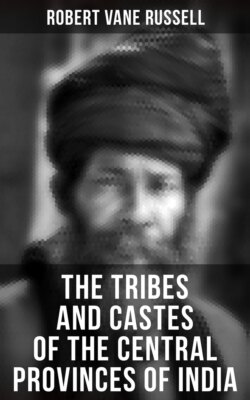Читать книгу The Tribes and Castes of the Central Provinces of India - Robert Vane Russell - Страница 10
На сайте Литреса книга снята с продажи.
Dhāmi, Prannāthi Sect.
ОглавлениеTable of Contents
Dhāmi, Prannāthi Sect.—A small religious sect or order, having its headquarters in the Panna State of Bundelkhand. A few members of the sect are found in the Saugor and Damoh Districts of the Central Provinces. The name Dhāmi is simply a derivative from dhām, a monastery, and in northern India they are called Prannāthi after their founder. They are also known as Sāthi Bhai, brothers in religion, or simply as Bhai or brothers. The sect takes its origin from one Prannāth, a Rājpūt who lived in the latter part of Aurāngzeb’s reign towards the end of the seventeenth century. He is said to have acquired great influence with Chatra Sāl, Rāja of Panna, by the discovery of a diamond mine there, and on this account Panna was made the home of the sect. Prannāth was well acquainted with the sacred books of Islam, and, like other Hindu reformers, he attempted to propagate a faith which should combine the two religions. To this end he composed a work in Gujarāti called the Kulzam Sarup, in which texts from the Korān and the Vedas are brought together and shown not to be incompatible. His creed also proclaimed the abolition of the worship of idols, and apparently of caste restrictions and the supremacy of Brāhmans. As a test of a disciple’s assent to the real identity of the Hindu and Muhammadan creeds, the ceremony of initiation consists in eating in the society of the followers of both religions; but the amalgamation appears to be carried no further, and members of the sect continue to follow generally their own religious practices. Theoretically they should worship no material objects except the Founder’s Book of Faith, which lies on a table covered with gold cloth in the principal temple at Panna. But in fact they adore the boy Krishna as he was at Mathura, and in some temples there are images of Rādha and Krishna, while in others the decorations are so arranged as to look like an idol from a distance. All temples, however, contain a copy of the sacred book, round which a lighted lamp is waved in the morning and evening. The Dhāmis now say also that their founder Prannāth was an incarnation of Krishna, and they observe the Janam-Ashtami or Krishna’s birthday as their principal festival. They wear the Rādha Vallabhi tilak or sect-mark, consisting of two white lines drawn down the forehead from the roots of the hair, and curving to meet at the top of the nose, with a small red dot between them. On the cheeks and temples they make rosette-like marks by bunching up the five fingers, dipping them in a solution of sandalwood and then applying them to the face.1 They regard the Jumna as a sacred river and its water as holy, no doubt because Mathura is on its banks, but pay no reverence to the Ganges. Their priests observe celibacy, but do not practise asceticism, and all the Dhāmis are strict vegetarians.
There is also a branch of the sect in Gujarāt, where the founder is known as Meherāj Thākur. He appears to have been identical with Prannāth, and instituted a local headquarters at Surat.2 It is related by Mr. Bhimbhai Kirpārām that Meherāj Thākur was himself the disciple of one Deo Chand, a native of Amarkot in Sind. The latter was devoted to the study of the Bhāgwat Purān, and came to Jāmnagar in Kāthiāwār, where he founded a temple to Rādha and Krishna. As there is a temple at Panna consecrated to Deo Chand as the Guru or preceptor of Prannāth, and as the book of the faith is written in Gujarāti, the above account would appear to be correct, and it follows that the sect originated in the worship of Krishna, and was refined by Prannāth into a purer form of faith. A number of Cutchis in Surat are adherents of the sect, and usually visit the temple at Panna on the full-moon day of Kārtik (October). Curiously enough the sect has also found a home in Nepāl, having been preached there, it is said, by missionary Dhāmis in the time of Rāja Rām Bahādur Shāh of Nepāl, about 150 years ago. Its members there are known as Pranāmi or Parnāmi, a corruption of Prannāthi and they often come to Panna to study the sacred book. It is reported that there are usually about forty Nepālis lodging in the premises of the great temple at Panna.3
1 Captain C.E. Luard, in Central India Census Report (1901), p. 88.
2 Bombay Gazetteer, Hindus of Gujarāt (Mr. Bhimbhai Kirpārām), p. 545.
3 This information was kindly furnished by the Diwān of Panna, through the Political Agent at Bundelkhand.
